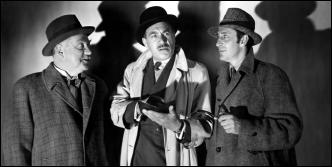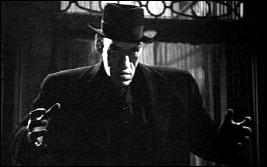Sun 20 Oct 2013
A Movie Review by Dan Stumpf: THE PEARL OF DEATH (1944).
Posted by Steve under Mystery movies , Reviews[7] Comments
THE PEARL OF DEATH. Universal, 1944. Basil Rathbone (Sherlock Holmes), Nigel Bruce (Doctor Watson), Dennis Hoey (Inspector Lestrade), Evelyn Ankers, Rondo Hatton. Based on the characters created by Sir Arthur Conan Doyle. Director: Roy William Neill.

One indisputable “B” Classic is The Pearl of Death, seventh in Universal’s Sherlock Holmes series with Basil Rathbone and Nigel Bruce, and my favorite of the set.
Holmes purists object to the modernizing of the series, and to the portrayal of Watson as a buffoon, but I find the atmosphere of these things charmingly old-fashioned — no car-chases or shoot-outs, and very sparing use of phones and electric lights — and I appreciate Nigel Bruce’s shtick for its own sake; every “B” series had to have Comic Relief and his was rather good of its type.
At that, Watson’s a couple laps ahead of Dennis Hoey’s delightfully dense Inspector Lestrade, whose exchange …

HOLMES – “Two persons found with their backs broken and smashed crockery all about. What do you make of that?”
LESTRADE – “Coincidence, I calls it.”
… seems impressively obtuse even for a Movie Cop.
But Pearl scores points mainly as an atmospheric horror movie. It offered Rondo Hatton his first “starring” part, in the expert hands of director Roy William Neil, who exploited “the Creeper” with real Gothic flourish. Here, as never before or since, there’s someone using camera angles, lighting and background to lend the character a screen presence that the actor never really had.
There’s also a particularly fine climax — memorable enough that it appeared again later that same year in the better-known Murder My Sweet.
October 20th, 2013 at 11:20 am
I thought, after seeing several in this series, that the relationship, not the story line, between Nigel Bruce and Cary Grant in Suspicion, was an extension of that between Bruce and Rathbone in this series.
October 20th, 2013 at 1:02 pm
Considering the recent modernizing of Sherlock Holmes by the BBC and CBS, the Universal approach was ahead of its time. Until Basil Rathbone and Nigel Bruce made The Hound of the Baskervilles in 1939 every Holmes films was set in the era contemporaneous to the time of filming. The year 1939 was sufficiently distant from the 1890s for 20th Century Fox to recognize the historical perspective.
October 20th, 2013 at 3:30 pm
Budget and the war had more to do with moving Holmes to contemporary settings in this case. When Fox let Universal pick up the series the latter could not afford the elaborate sets of Hound and The Adventures. Modern settings were unavoidable, and following the line of His Last Bow (quoted in the first of the Universal Holmes — “There’s an east wind coming …”)having Holmes involved in the war effort was a natural.
Distanced by time we forget how contemporary Doyle’s now timeless tales were at the time. Readers of Charles Augustus Milverton were well aware the lady in the portrait was soon to be Tzarina Alexandra; the king of Bohemia was the heir apparent to Victoria’s throne; the explorer in “The Devil’s Foot” was Sir Richard Burton, and so on. Much like the Fleming effect, the Doyle effect was to mix the real world with Holmes world. These tales were not quaint or historical when written — Holmes employs telephones and autos when needed.
As for Bruce, while he might not have been Doyle’s Watson, he was always a delight on screen, and had more range than might be expected. Catch him as Myrna Loy’s obnoxious husband in The Rains Came to see my point or in Vanity Fair with Miriam Hopkins. He was equally good on radio in the series with Rathbone written by writers like Anthony Boucher and Leslie Charteris.
The Rathbone films have good credits as well. Neil’s direction (The Scarlet Claw is my pick for best of series)and writers like Frank Gruber didn’t hurt either. Then again, even late in the series the guest cast was unusually good, including former Watson Alan Mowbray as Colonel Sebastion Moran.
Denis Hoey’s Lestrade is so embedded in my imagination half the time I don’t recognize him in the numerous other films he did.
And you might keep in mind that when Holmes first came to the screen Conan Doyle was alive and still writing about him. Our view of him as a historical character was not how he was seen then. When Wotner did his talkie Holmes films Doyle had only been dead a few years and Casebook was a relatively new book.
Still, as Vincent Starrett said, in Holmes world “it is always London 1895.”
This atmospheric film is easily the best use of Rhondo (The Creeper) Hatton’s facial deformation. I realize there is an exploitation factor there, but from everything I’ve read Hatton was happy to be in films and have a short time of fame before his early death. He seemed to me to enjoy the few films he did though you never know what’s in someone’s soul.
October 20th, 2013 at 3:49 pm
Nigel Bruce is a wonderful actor. Check him out in The Exile and She.
October 20th, 2013 at 4:08 pm
She yes, wholly agree.
Where did you find a copy of The Exile — assuming you mean the Doug Fairbanks Jr. one.
October 20th, 2013 at 4:36 pm
Oh, yes. Haven’t seen it for years but Marvin (of the movies) sent it to me. No Sepia but quite okay. There have to be gray market copies around. In any case, quite good and Bruce is warm and wonderful as Clarendon.
September 30th, 2020 at 7:36 pm
[…] Hollywood for years until someone spotted him for a choice part in PEARL OF DEATH (1944: reviewed here ) a superior entry in the Sherlock Holmes series which used Hatton sparingly and to eerie […]